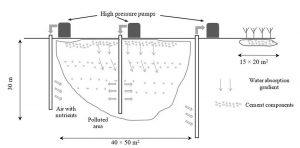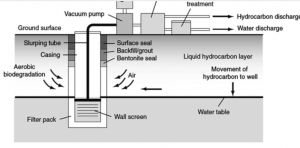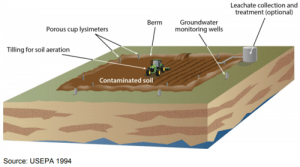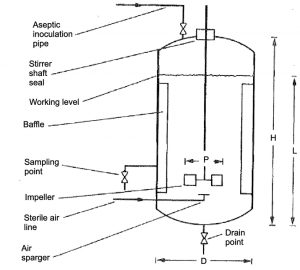Contents:
Bioremediation Introduction
- Bioremediation is characterized as the process where, under regulated conditions, organic waste is biologically degraded to a harmless state or to levels below the limits of concentration set by the regulatory authorities.
- Bacteria, fungi, or plants that have the biochemical capacities to degrade, detoxify, or render the toxins harmless might be the acceptable species.
- It is used to use microorganisms such as microbes and fungi or plants to kill immobilized waste materials.
- Bioremediation cleans one or more bacteria from toxic substances in the atmosphere, which are then turned into water and harmless gases such as carbon dioxide. They attack the toxins enzymatically,
- The microorganisms may be endemic to the polluted environment or are isolated and transported to the contaminated site from elsewhere.
- Bioremediation happens only when microbial growth and activity are allowed by environmental factors and the resulting manipulation often helps in the process.
Types of Bioremediation
Bioremediation has done a great advance that helps in decontaminating soil and groundwater and has helped clean up oceans after oil spills and other environmental disasters.
The various types of bioremediation are as follows.
Microbial Bioremediation- Here the micro-organisms are used to degrade the contaminants by using them as a nutrition source.
Phytoremediation- This uses plants for the binding, of extract, and clearing up pollutants such as pesticides, petroleum hydrocarbons, metals, and chlorinated solvents.
Mycoremediation– This uses fungus as digestive enzymes for the degradation of contaminants such as pesticides, hydrocarbons, and heavy metals.
Factors Affecting Bioremediation
This involves—
- Existence of a microbial species– When they later develop and expand under severe circumstances, microorganisms can be separated from almost all environmental conditions.
- Availability of pollutants to the microbial population-The source of carbon is the key necessity.
- Environmental variables (soil type, temperature, pH, oxygen or other electron acceptor presence, and nutrients).
Ex- Aerobic microorganisms (Grows in presence of oxygen)- Pseudomonas, Alcaligenes, Sphingomonas, Rhodococcus, and Mycobacterium
Anaerobic (Grows in absence of oxygen)- chloroform, Methylotrophs
Bioremediation Techniques
Bioremediation techniques can be divided into two broad categories: In situ bioremediation and ex-situ bioremediation
In-situ bioremediation
These approaches include the disposal of polluted chemicals at a pollution site. It needs no excavation; it is also accompanied by little to no disruption of the composition of the earth.
Bioventing
- To enhance the biodegradation of soils polluted with organic pollutants, it employs comparatively low-flow soil aeration techniques.
- It is primarily used for unsaturated soils, but air-sparging applications also aim to remediate saturated soils and groundwater.
- Most are used for vacuum extraction, air injection, or a mixture of both methods.
- Commonly used are an air compressor, one or two air injections or vacuum extraction probes, and ground surface level pollution sensors.

Bioslurping
- This approach incorporates vacuum-enhanced pumping, extraction, and bioventing of soil vapor to accomplish soil and groundwater remediation through indirect oxygen supply and enhancement of biodegradation of pollutants.
- Soils polluted with volatile and semi-volatile organic compounds may also be used to remediate them.
- While the method is not appropriate for low permeability soil remediation, it saves costs because of less groundwater arising from the process, thereby reducing storage, treatment, and disposal costs.

Biosparging
- To facilitate pollutant clearance from contaminated areas, the air is pumped into the soil subsurface to induce microbial activities.
- The efficacy of biosparging relies on two key factors: soil permeability, which specifies the bioavailability of contaminants to microorganisms, and biodegradability of pollutants.
- Biosparging has been commonly used in the treatment of petroleum-contaminated aquifers, particularly diesel and kerosene.
Phytoremediation
- This approach is focused on the use of plant associations in contaminated sites (physical, physiological, environmental, chemical, and microbiological) to mitigate the harmful effects of contaminants.
- Phytoremediation shows the capacity to accumulate, immobilize, and create harmless environmental toxins.
- The phytoremediation process has two approaches: (1) organic pollutants can be picked up immediately by plants and degraded within plants, (2) enzymes are secreted by plants and organic pollutants can be degraded.
- There are many processes (accumulation or extraction, oxidation, filtration, stabilization, and volatilization) involved in phytoremediation, depending on the pollutant form (elemental or organic).
- The approach to phytoremediation mainly depends on maximizing the capacity for remediation of native plants growing in contaminated areas, either by bioaugmentation with endogenous or exogenous plant rhizobacteria or by biostimulation.
- The use of plant growth-promoting rhizobacteria (PGPR) could play an important role in phytoremediation, as PGPR helps to increase the development of biomass and plant resistance to heavy metals and other unfavorable soil conditions.
Biostimulation
- Through supplying nutrients and oxygen to support indigenous microorganisms such as nitrogen , phosphorous, and biomass, the development and operation of the microorganisms may be stimulated.
- In the act of using toxins for their own growth and reproduction, microorganisms kill biological pollutants.
- The oxidation of organic chemicals allowing the transition of electrons (energy sources) from organic chemicals such as carbons to certain electron acceptors is catalyzed by cells.
Permeable reactive barrier (PRB)
- Due to its nature and process of pollutant elimination, this procedure is often viewed as a physical tool for remediating polluted groundwater. PRB is an in situ process used to fix groundwater contaminated with various forms of toxins, including heavy metals and chlorinated compounds.
- In this procedure, in the direction of contaminated groundwater, a permanent or semi-permanent reactive barrier (medium) often composed of zero-valent iron is submerged.
- When dirty water flows under its normal gradient through the barrier, contaminants are caught and undergo a sequence of reactions that result in clean water flowing through it.
Intrinsic bioremediation
- Intrinsic bioremediation, also known as natural attenuation, is an in situ bioremediation strategy that requires, without any external force (human intervention), passive remediation of contaminated areas.
- The method depends on both aerobic and anaerobic microbial processes for the biodegradation of polluting compounds, including recalcitrant ones.
- One of the main drawbacks of intrinsic bioremediation is that, provided that no external force is incorporated to speed up the remediation process, it could take a longer time to reach the desired level of pollutant concentration.
Ex-situ bioremediation
- Bioremediation often takes place by natural means such as inherent bioremediation or natural attenuation.
- These strategies include excavating contaminants from contaminated areas and then transferring them for disposal to another location.
- The techniques of ex-situ bioremediation are commonly regarded on the basis of the cost of treatment, the depth of contamination, the type of pollutant, the degree of pollution, the geographical location, and geology of the contaminated site.
Bioremediation in solid-phase
- It contains treatment units inlined soil or composting piles.
- A prepared bed reactor with a leachate collection system and irrigation and fertilizer distribution systems is used in a lined soil treatment unit.
- The device can also provide equipment to monitor air emissions. The soil, such as grass, cement, or a plastic liner, is built on the ground lined with an impervious layer.
Land Farming
- Landfarming, which includes scattering polluted soils over a wide area, is often used in ex-situ processes.
- Bioremediation can also be carried out in a bioreactor in which water in a mixing tank or lagoon slurries the polluted soil or sludge.
- Bioremediation systems require adequate and homogeneous mixing of the polluted soil or sludge to ensure optimal interaction with the seed species.

Windrows
- Windrows rely on the periodic turning of piled polluted soil to improve bioremediation by increasing degradation activities of indigenous and/or transient hydrocarbonoclastic bacteria present in infected soil,
- The use of windrow therapy was involved in the treatment of CH4
Biopile treatment
- It includes the mixing of soil modifications of excavated soils, putting on a treatment area, and bioremediation using forced aeration.
- It is a land-farming and composting combination.
- A treatment bed, an aeration system, an irrigation/nutrient system, and a leachate collection system are used in the simple bio-pile system.

Bioreactors
- In certain aspects, the bioreactors are constructed, but most are a modification of one of two systems.
- In the first method, which is sometimes referred to as a fixed media system or trickling filter. In order to combine the toxins, modifications, and micro-organisms, the second typical bioreactor configuration uses a sealed vessel. For bioremediation, this can be used.
- There are different operating modes of the bioreactor, which include: batch, fed-batch, sequencing batch, continuous and multistage.
- Bioreactor environments facilitate the cells’ natural process by imitating and preserving their natural environment in order to provide optimal conditions for growth.
- In order to efficiently minimize bioremediation time, the ability to monitor and modify process parameters in a bioreactor means that biological reactions inside can be improved.

Advantages of Bioremediation
- Bioremediation offers numerous advantages over other clean-up methods. By relying solely on natural processes, it minimizes damage to ecosystems.
- Bioremediation often takes place underground, where amendments and microbes can be pumped in order to clean up contaminants in groundwater and soil.
- Consequently, bioremediation does not disrupt nearby communities as much as other clean-up methodologies.
- The bioremediation process creates relatively few harmful by-products (mainly due to the fact that contaminants and pollutants are converted into water and harmless gases like carbon dioxide).
- Finally, bioremediation is cheaper than most clean-up methods because it does not require substantial equipment or labor.
- By the end of 2018, the United States Environmental Protection Agency (EPA) had brought bioremediation activities to a total of 1,507 sites.
Limitations of biodegradation
- Bioremediation is an evolving technique that can be used for the full control of different classes of environmental toxins concurrently with other physical and chemical treatment processes.
- It appears to be a sustainable solution to the management of environmental emissions and, thus, further study is required in this field.
- The required environmental conditions for microbial development, the presence of metabolically active microbial species, and sufficient amounts of nutrients and pollutants are other factors impacting biodegradation.
Conclusion
Bioremediation is an evolving technique that can be used for the full control of different classes of environmental toxins concurrently with other physical and chemical treatment processes. It appears to be a sustainable solution to the management of environmental emissions and, thus, further study is required in this field.
References
- https://www.ncbi.nlm.nih.gov/pmc/articles/PMC5026719/
- https://www.sciencedirect.com/topics/earth-and-planetary-sciences/bioremediation
- https://www.researchgate.net/figure/A-schematic-view-of-bioslurping-technology-USEPA-2006_fig3_327727824
- https://www.researchgate.net/figure/Biopile-system-FRTR-2000_fig3_287574661
- https://www.enviro.wiki/index.php?title=Landfarming
